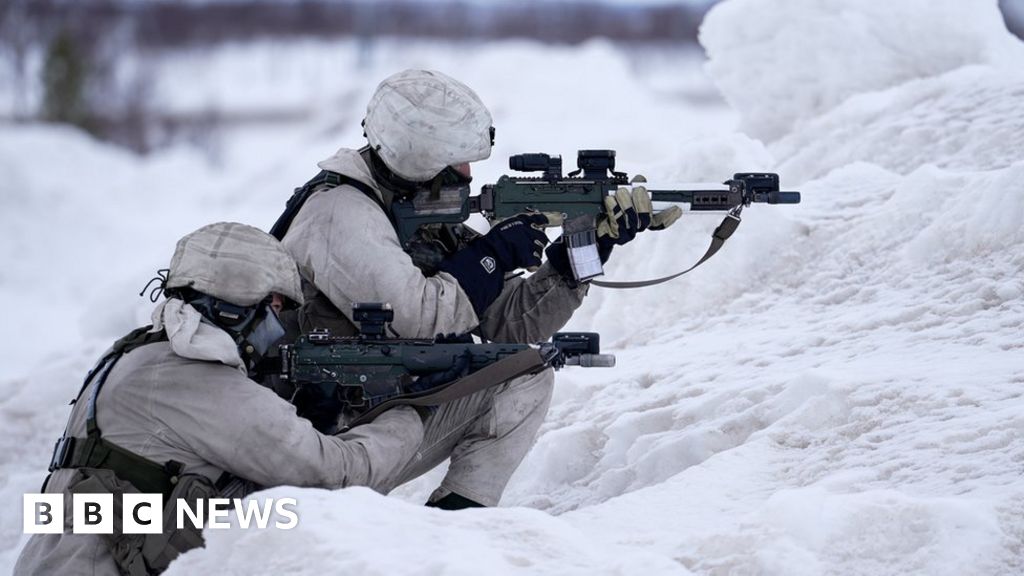- By Jonathan Beale
- Defence correspondent. northern Norway
There was a time when Nato would do its best to avoid direct mention of Russia when conducting its military manoeuvres. Not least for fear of provocation. But Russia’s full scale invasion of Ukraine has changed all that.
Now the alliance’s drills have Moscow in mind. One of the key stated objectives of Exercise Steadfast Defender is to deter Russia. It’s the alliance’s largest since the end of the Cold War, involving 90,000 military personnel and taking place right across Europe’s eastern flank over the next few months.
Steadfast Defender is also the first test of Nato’s new military plans – designed to move troops and equipment at speed and scale to bolster any ally under attack. And it’s an affirmation of the very purpose of Nato – that an attack on one would prompt a response from all.
Donald Trump may have called that into question, but America remains the backbone of that pledge and has committed huge resources to prove it.
The first stage of the exercise is taking place in the remote white wilderness of the Finnmark region of northern Norway. It’s not that far from Norway’s 120-mile border with Russia. Though in this scenario Finnmark’s been invaded by a fictional enemy called Occasus.
Eivor, a 21-year-old Norwegian medical student and part-time soldier, says her grandparents had to flee this same area when the Nazis invaded in World War Two.
“I’d rather stay here and fight,” she says. She says she’s not expecting the Russians to invade “but of course you always have to stay on your toes”.
It’s the first big Nato exercise with forces from Sweden and Finland taking part as fully fledged members.
There’s a palpable sense of excitement among their troops at becoming part of the world’s largest military alliance. They’re also more willing to identify the threat.
Preparing for a beach assault in a fjord, one Finnish marine said it made no sense for his country “being alone against Russia”. Another adds: “Nato kind of scares Russia.” A fellow Swedish marine says he feels “super safe” now his country’s finally joined the Alliance.
It’s a sentiment shared by their politicians too.
The defence ministers of Sweden, Finland and Norway celebrated their new Nordic unity as they watched part of the exercise – a symbolic border crossing of troops from Finland into Norway to expel the fictional invaders.
They were all smiles as they posed for photos in front of a rocket launcher.
Sweden’s defence minister, Pal Jonson, was not afraid to rub salt into Russia’s self-inflicted wounds. He described Sweden and Finland’s membership as “the mother of all unintended consequences” for Moscow.
Russia he said had been desperate to stop the two previously non-aligned countries from joining. It had failed.
Though in truth Finland’s membership has also brought Russia closer to Nato – with a shared border of more than 800 miles, which allies too will now have to be ready to defend.
How real is the threat?
No-one’s saying that Russia’s an imminent threat. Not least because its forces are currently bogged down in Ukraine. But there is a perception that longer term Russia could target a Nato country too.
One of Sweden’s most senior military commanders has no doubts that Moscow’s ambitions go further than Ukraine.
Lieutenant General Carl-Johan Edstrom says it’s a question of time – “I’m sure Russia is a threat, yes, and we need to be stronger in the coming five to 10 years”.
Nato, he says, must use that window to strengthen its armed forces.
Several other European military chiefs and senior politicians have also warned that Russia could attack a Nato ally within the next decade.
Vice-Admiral Doug Perry, one of the senior US military chiefs overseeing the exercise, says it’s clear to him “the European continent’s already at war”.
For now, that’s confined to Ukraine. But he says Nato needs to “evaluate Russian behaviour and Russian capability. Add them up and we must be prepared”.
He believes Finland and Sweden’s recent membership of Nato is a reflection of that threat.
Nordic nations, like the Baltic States, appear to have a more acute sense of the danger. It’s what comes with living closer to Russia.
They’re the ones ramping up defence spending faster than others. They’re also the states which often understand the costs of war – having lived through the bitter experience of invasion in the past.
In the Nordic states defence is also drilled into the population – unlike anywhere else in Europe. They all have some form of conscription, meaning that every generation has military experience and many continue to serve in the reserves.
But not everyone in Nato is as well prepared. Elsewhere in Europe, including the UK, armies are struggling to recruit.
Among the professional troops taking part in this exercise are members of Norway’s home guard – mostly part-time soldiers.
For this exercise they’re acting as the enemy, moving fast across the snow-covered hills by skidoo and sleeping outside in freezing temperatures. Most are young – this is no Dad’s Army.
Josefine, a 21-year-old Kindergarten teacher, says “we have a lot of people with military experience and that kinds of makes it safer, because we are everywhere.”
Elisabeth, a 20-year-old nurse, says “it’s important to have people who really want to defend Norway, so we can all feel safe”.

